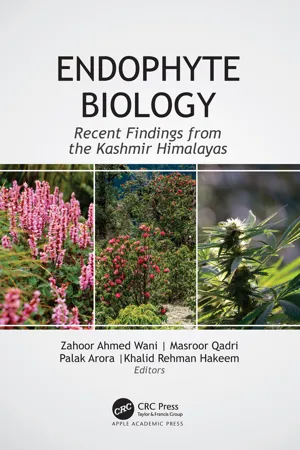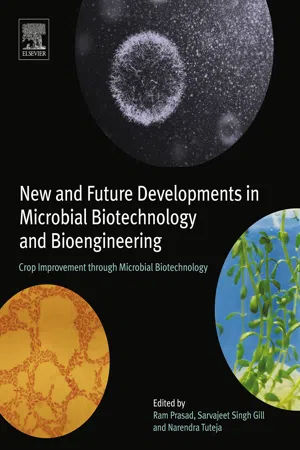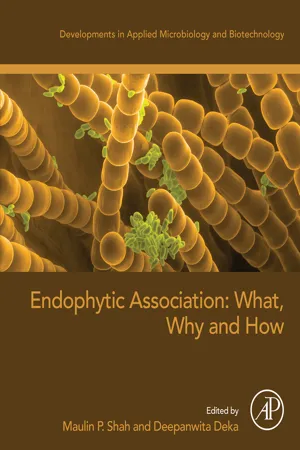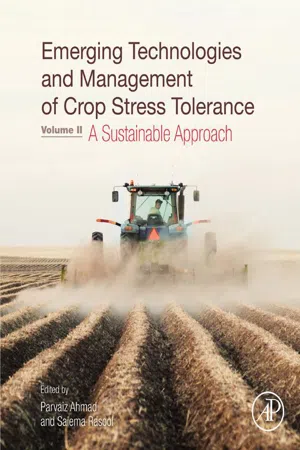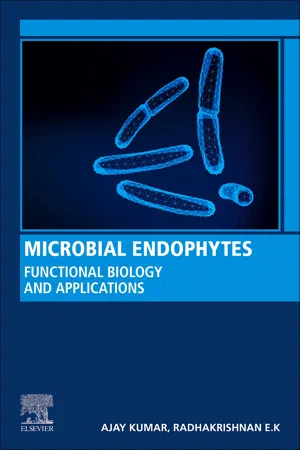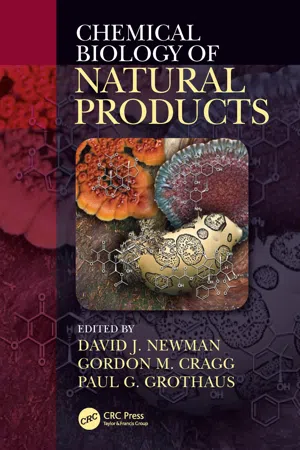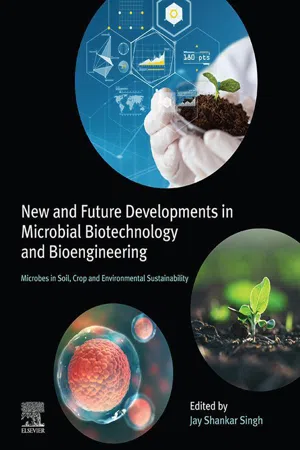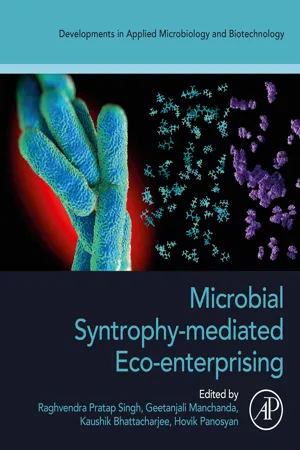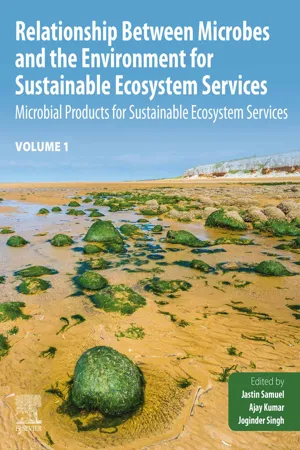Biological Sciences
Endophytes
Endophytes are microorganisms, such as bacteria or fungi, that live within the tissues of plants without causing any apparent harm. They form a symbiotic relationship with the host plant, providing benefits such as enhanced growth, stress tolerance, and protection against pathogens. Endophytes have potential applications in agriculture, medicine, and biotechnology due to their diverse metabolic capabilities and bioactive compounds.
Written by Perlego with AI-assistance
Related key terms
10 Key excerpts on "Endophytes"
- eBook - ePub
Endophyte Biology
Recent Findings from the Kashmir Himalayas
- Zahoor Ahmed Wani, Masroor Qadri, Palak Arora, Khalid Rehman Hakeem(Authors)
- 2022(Publication Date)
- Apple Academic Press(Publisher)
1.1 Microscopic examination of endophytic fungal colonization in plant tissues. (A) Blue-stained structures showing extensive colonization of endophytic fungi, (B) melanized microsclerotia of DSEs inside plant tissues, and (C) chlamydospores-like structures inside plant tissues. (Reprinted with permission from Wani et al. 2016, ©Elsevier)1.2 History And Definition Of Endophytes
Endophytism as a natural phenomenon is a question of history, and its origin probably dates back to the existence of plants on the planet earth (Redecker et al., 2000 ). However, the advancement of endophyte biology as a discipline of science began in the year 1866 when De Barry put forth the concept of “endophyte.” The term endophyte (Gr. endon, within; phyton, plant) was first coined by De Barry to refer “any organism occurring within the plant tissues” (De Barry, 1866). Endophyte is defined in several ways and the definitions are modified as the research advances (see Box 1.1 for various definitions of Endophytes). However, most appropriately an endophyte can be defined as an organism that inhabit the plant organization, at least for a part of its life cycle, without producing any apparent disease symptoms in the host plant under normal conditions (Wilson, 1995 ). Evidence of plant-associated microbes is reported in the fossilized tissues of stem and leaves (Taylor and Taylor, 2000 ). As a result of these long-held associations, it is possible that some of the endophytic microbes may have devised genetic systems to allow transfer of information between the microbe and the plant partner and vice versa (Freeman and Rodriguez, 1993 ; Stierle et al., 1993 ). However, Endophytes did not receive much attention until the recent recognition of their pharmaceutical and ecological significance (Gunatilaka, 2006 ). Since then, Endophytes have created immense scientific curiosity pertaining to their biology, evolution, ecology, and applications.Contrary to the mycorrhizal symbioses, Endophytes do not form cellular interfaces with specialized structures, like arbuscules in the case of arbuscular mycorrhizal fungi. Endophytes have not synchronized their development to the plant partner and the host plant may not get benefit from endophytic colonization, as in the case of commensalism (Brundrett, 2002 ). The presence of endophyte was first reported by Vogel in 1898 , who revealed a mycelium residing in the seed of an annual grass darnel (Lolium temulentum) (Vogel et al., 1898 ). Later in 1904, Freeman isolated an endophytic fungus from the seeds of L. temulentum (Freeman, 1904). Since then, Endophytes have been isolated from all the plants, including mosses, bryophytes, pteridophytes, gymnosperms, angiosperms, and even from lichens, studied till date (Arnold and Luzoni, 2007; Porras-Alfaro and Bayman, 2011 ; Wani et al., 2015 , 2016 ; Qadri et al., 2014 - eBook - ePub
New and Future Developments in Microbial Biotechnology and Bioengineering
Crop Improvement through Microbial Biotechnology
- Ram Prasad, Sarvajeet Singh Gill, Narendra Tuteja(Authors)
- 2018(Publication Date)
- Elsevier(Publisher)
The word endophyte means “in the plant” (endon Gr., within; phyton, plant). They are ubiquitous in nature and show association with nearly 300,000 plant species that exist on the earth. Each individual plant is host to one or more Endophytes. The use of term was argued as most of the microorganisms do not show any symptoms during initial infection. Petrini (1991) added a new dimension in the characterization of endophytic interactions where the absence of macroscopically visible symptoms was considered as “causing no apparent harm.” The term “endophyte” is mostly used to portray bacteria and fungi “asymptomatic” microbial colonization as a balance of antagonisms between host and endophyte at a particular moment (Hallmann et al., 1997 ; Schulz and Boyle, 2005, 2006). The short-lived and delicate balance of antagonism depends on the general status of the host, that is, defense mechanism, nutritional status, different environmental factors, and developmental stages of the endophytic partners. Endophytes are microorganisms, that is, bacteria or fungi or actinomycetes reside in the living tissues of plants intercellularly and/or intracellularly without causing any harm and symptoms of disease (Wilson, 1995). Though, Endophytes are potential sources of novel natural compounds that can be used in agriculture, medicine, and industry but relatively under studied. They can establish mutual or symbiotic relationship with host plants and can be obligatory or facultative in nature (Carroll, 1988). Interaction between plants and Endophytes produces compounds of enormous value for plant growth, protection to environmental conditions, and sustainability, in good turn of dwelling place inside the hosts. The bioactive compounds produced by Endophytes have an economical importance to humans as antibiotics, drugs, or medicines or show importance in food industry. Their role in nutrient cycling, bioremediation, and biodegradation has also been explored to some extent - eBook - ePub
- Maulin P. Shah, Deepanwita Deka, Maulin P. Shah, Deepanwita Deka(Authors)
- 2022(Publication Date)
- Academic Press(Publisher)
Sturz and Nowak, 2000 ).18.2 Endophytes
Endophytes at its simplest can be defined as organisms that live inside the plants commonly associated with bacteria and fungi (Fig. 18.1 ) and does not cause any visible disease symptoms (Wilson 1995 ). Endophytes show great diversity and belongs to different region such as temperate, tropical regions, and in boreal forests (Zhang et al., 2006 ). They are known to inhabit almost all plants and have been isolated from different parts of plant including root, shoot, leaves, fruits, and buds (Nair et al., 2014 ). Plant associated Endophytes are thought to originate from the soil by infecting root junction through the cracks or wounds in the lateral root junction and spread to intercellular spaces. Root cracks are believed to be the “hot spots” especially for bacterial colonization and they are also transmitted through seeds (Hardoim et al., 2008 ; Chi et al. 2005 ). Endophytes can be characterized into three main groups based on functionality as plant growth promoters, biocontrol agents, and plant stress homeoregulating microbes. They are also characterized into three main groups based on distribution such as obligate Endophytes (proliferate only inside host plant), facultative Endophytes (which is usually free-living but can colonize plant through coordinated infection under favorable condition), and passive Endophytes (that does not show active colonization however invasion may occur through wounds or abrasion in the root curls) (Tewari et al., 2019 ). Plant–microbe interactions are mainly through commensalism and mutualism. Endophytes are provided with undisturbed existence and nutrients in the host cell through commensalism, while mutualism benefits both the organism and frequently results in the growth promotion of host plants (Kogel et al., 2006 ). Bacteria are known to colonize intercellularly and frequently found in the vascular tissues of host plants, though they are also found intracellularly. On the other hand, asymptomatic colonization by fungi may be inter- and intra-cellular respectively (Schulz and Boyle, 2006 ). Excessive studies on Endophytes further reveals that within the plant system Endophytes are more diverse and abundant than plant pathogens (Ganley et al., 2004 ). Within the host, Endophytes and plant pathogens live in the same environmental condition and thus compete which may cause damages and stress to healthy plants (Duijff et al., 1997 ). This is one positive aspect of endophyte as biocontrol agent. Moreover, they can promote plant growth through several mechanisms such as production of phytohormones, nitrogen fixation, mineral solubilization mainly phosphorus, calcium, and siderophore production to chelate iron and production of bioactive metabolites that can enhance plant development and stress tolerance (Taghinasab and Jabaji 2020 - eBook - ePub
Emerging Technologies and Management of Crop Stress Tolerance
Volume 2 - A Sustainable Approach
- Parvaiz Ahmad, Saiema Rasool(Authors)
- 2014(Publication Date)
- Academic Press(Publisher)
The interaction of microbes with plants is a dynamic, sophisticated phenomenon wherein several external factors affect the structure and species composition of the bacterial communities. An understanding of microbial composition that is associated with plants is fundamental to understanding how plants’ biological processes are influenced by environmental factors. Plant growth and development cannot be adequately described without acknowledging microbial interactions. As a poorly investigated store of microorganisms “hidden” within the host plants, Endophytes are obviously a rich and reliable source of many secondary metabolites, which may be helpful in providing resistance to plants against insects, nematodes, and pathogenic fungi and bacteria. They live within the intercellular spaces and may confer benefits to the plant and the benefits may be reciprocal, resulting in an enhanced symbiotic system for specific plant characteristics. Therefore, the use of endophytic bacteria and fungi opens up a new area of biotechnological exploitation that drives the necessity to isolate and culture these organisms.The biochemical versatility and diversity of Endophytes represents an enormous variety of genes that are still unknown. More and more useful gene functions are being discovered, particularly for environmental remediation and industrial processes. Microorganisms living within plant tissues for all or part of their life cycle, without causing any visible symptoms of their presence, are defined as Endophytes. Plants benefit extensively by harboring these endophytic microbes; they promote plant growth and confer enhanced resistance to various pathogens by producing antibiotics. Endophytes also produce unusual secondary metabolites important to plants under stress conditions together with some valuable pharmaceutical substances of biotechnological interest. Endophytes represent a huge diversity of microbial adaptations that have developed in special and sequestered environments, and their diversity and specialized habituation make them an exciting field of study in the search for new metabolites. In view of their widespread application in plant and human health and the environment, concerted efforts at endophytic diversity searches, coupled with exploitation, are necessary on account of varied and unique plant diversity. - eBook - ePub
Microbial Endophytes
Functional Biology and Applications
- Ajay Kumar, E.K. Radhakrishnan(Authors)
- 2020(Publication Date)
- Woodhead Publishing(Publisher)
Rohini et al., 2018 ). Although several metabolites from plants and microbes have been fully characterized, their roles in the chemical interplay between these partners are not well studied. Hence, the current chapter describes the interaction, colonization, and mechanisms of plant growth promotion by endophytic organisms which can be utilized for the sustainable agricultural practices.2.2. Endophytic microorganisms
Microbial Endophytes are microsymbionts, which includes culturable and nonculturable microorganisms that inhabit the interior of the plant tissue and spend their life cycle without causing any detrimental effect to the host plant. The ability to enter and thrive in the plant tissues makes the Endophytes unique and it exhibits multidimensional interactions within the host plant. The term “Endophyte” was first introduced by De Barry (1866) . The most popular definition of endophyte is proposed by Hallmann et al. (1997) who stated that Endophytes can be defined as the microorganisms that can be isolated from surface-disinfected plant tissue or extracted from within the plant. Hardoim et al. (2015) defined Endophytes as microbes including bacteria, archaea, fungi, and protists that colonize the plant interior regardless of the outcome of the association. Usually, these endophytic microorganisms can be isolated by traditional culture-based method such as surface sterilization of the plant tissue followed by the inoculation onto the culture media (Jasim et al., 2013 ). Recently, many culture-independent approaches are introduced such as genome sequencing of the 16S rRNA gene, the internal transcribed spacer regions, or through the whole genome sequencing of plant material to identify the plant-associated microorganisms at the genus and the species level by comparing with the available databases (Sessitsch et al., 2012 ; Taghavi et al., 2009 ; Ikeda et al., 2010 ; Turner et al., 2013 - eBook - ePub
Microbial Endophytes
Prospects for Sustainable Agriculture
- Ajay Kumar, Vipin Kumar Singh(Authors)
- 2019(Publication Date)
- Woodhead Publishing(Publisher)
2Endophytic bacteria from the medicinal plants and their potential applications
R. Aswani; P. Jishma; E.K. Radhakrishnan School of Biosciences, Mahatma Gandhi University, Kottayam, IndiaAbstract
Endophytic bacteria can be defined as those which colonize the interior tissues of plants without causing any adverse effect. A large number of endophytic bacteria have been extensively characterized from various medicinal plants due to its wide range of biosynthetic potential. The mutualistic association of endophyte with plants enables the plant to manage diverse stress conditions. The biocontrol properties of these microorganisms make them to have the promises to protect the plants from various pathogenic attacks. Even though chemical fertilizers and pesticides are used to manage crop diseases, the toxicity and environment pollution caused by them demand the need for environment friendly approaches to improve the agricultural production in a safe and cost-effective manner. Hence, endophytic microbiome has been identified as a significant alternative to be applied in the agriculture field. Even though many studies have been done so far pertaining to the endophytic bacterial association with medicinal plants, a detailed insight into their adaptive mechanisms and the metabolite potential is least explored. Thus, this chapter describes the biosynthetic and plant beneficial features of the endophytic bacteria associated with medicinal plants and their role in plant disease management to increase agricultural productivity along with the development of bacterial formulations for field applications. - eBook - ePub
- David J. Newman, Gordon M. Cragg, Paul Grothaus(Authors)
- 2017(Publication Date)
- CRC Press(Publisher)
The biology and chemistry behind these associations and the driving forces or triggers involved should be elucidated on a case-by-case basis to get a holistic view of plant-endophyte mutualism in an ecosystem. Herein, we provide a conceptual overview of plant-endophyte interactions that have been elucidated by several recent studies on different facets of microbial relationship with plants, including relevant examples from our group. 7.2 Endophytes at the Center Stage of Nature’s Biological Marketplace Plant-associated Endophytes (Figure 7.1) live in a beneficial symbiosis with their hosts. Although the strategies coevolved by Endophytes for living and functioning in different ecological niches are still open to future exploration, multitrophic physiological and biochemical interactions underlying their crosstalk are known to be crucial. 1, 2, 3, 4 For proper functioning of ecosystem processes, a plethora of multiplexed and dynamic crosstalk occurs between Endophytes (exemplified by endophytic fungi, endophytic bacteria, endophytic viruses, and other micro- and nano-organisms), concordant with their associated host plants, under various biotic and abiotic conditions (Figure 7.1). 5, 6 FIGURE 7.1 Schematic representation of the network of endophytic microbiota in plants comprising a plethora of macro- and microorganisms. (a) Endophytic bacterial communities. (b) Endophytic fungi. (c) Endophytic bacteria. (d) Endophytic fungus containing endosymbiotic bacteria. (e) Endophytic viruses. (f) Invading insects, pests, and feeders. (g) Invading pathogens. The intricate network of interactions occurring between plants and associated microbiomes might be further exemplified using the “biological market theory.” 7, 8 Notably, an analogy between the - eBook - ePub
New and Future Developments in Microbial Biotechnology and Bioengineering
Microbes in Soil, Crop and Environmental Sustainability
- Jay Shankar Singh(Author)
- 2019(Publication Date)
- Elsevier(Publisher)
An incessant rise in global population combined with a steep reduction in arable land has led to a significant loss in agricultural production. In addition, use of poor land management practices as well as an increased use of chemical fertilizers and pesticides have resulted in a drastic decline of the agro-economy. Use of plant growth promoting bacteria (PGPBs) as biofertilizers and biopesticides offers a promising alternative to ensure sustainability in agriculture. However, a full-fledged exploitation of PGPBs in agriculture requires a thorough understanding of the host–bacterial interaction in an applied setting, for example, under stress conditions. In line to the aforementioned perspective, plants have evolved a variety of mechanisms over millions of years to cope with various forms of environmental stresses. Hosting of Endophytes within the plants’ interior is one such mechanism to successfully cope with environmental stresses as well as augment growth and productivity.Endophytes are particular microbes carrying out the entire or a part of their life cycle within the host interior. Though a complete understanding of endophytic benefit for adapting to such a lifestyle has not yet been comprehended, endophyte mediated host benefits, particularly under adverse conditions, have been much documented. Conrath et al. (2015) reported that endophytic microbes systemically prime host plants for an augmented broad spectrum defense response against phytopathogens. Similarly, reports validate endophyte mediated host defense enhancement against a variety of abiotic stresses (Ali et al., 2014 ). An interesting report by Beltran-Garcia et al. (2014) demonstrated digestion of endophytic bacteria by Agave tequilana for fulfillment of nitrogen requirement. In yet another report, Coutinho et al. (2015) reported an efficient interaction of endophytic microbes with host plants as compared with the rhizospheric microbes under diverse environmental conditions. Thus, the scope of exploitation of the intimate association of endophytic microbiota with host in terms of agricultural productivity under diverse conditions cannot be ignored.Though the endophytic diversity particularly within the root tissues has been much elucidated, the gradual change in phytomicrobiota with space and time has still remained a matter of research. In the current chapter, the authors aim to thoroughly focus on the (1) latest updates to reveal the phytomicrobiota with precision, (2) types of bacteria thriving in endophytic lifestyle, (3) modes of transmission of endophytic microbiota within hosts, (4) host mediated phytohormone production and their role in endophytic colonization, as well as (5) host–endophyte interaction for enhancing host productivity and defense. The chapter will be a minor attempt towards a better comprehension of host–endophyte interaction, which may further lead to development of new strategies for sustainable agriculture. - eBook - ePub
- Raghvendra Pratap Singh, Geetanjali Manchanda, Kaushik Bhattacharjee, Hovik Panosyan(Authors)
- 2022(Publication Date)
- Academic Press(Publisher)
Current Aspects of European Endophyte Research . France: University of Reims; 2012:28–30.Schulz and Boyle, 2005 Schulz B., Boyle C. The endophytic continuum . Mycol. Res. 2005;109:661–686. doi:10.1017/S095375620500273X.Schulz et al., 1999 Schulz B., Roemmert A.K., Dammann U., Aust H.J., Strack D. The endophyte-host interaction: a balanced antagonism? . Mycol. Res. 1999;103(10):1275–1383.Sekar et al., 2016 Sekar J., Raj R., Prabavathy V.R. Microbial consortial products for sustainable agriculture: commercialization and regulatory issues in India . In: Singh H.B., Sarma B.K., Keswani C., eds. Agriculturally Important Microorganisms . Singapore: Springer Science + Business Media; 2016:107–131.Selim et al., 2017 Selim H.M., Gomaa N.M., Essa A.M.Application of endophytic bacteria for the biocontrol of Rhizoctonia solani (Cantharellales: ceratobasidiaceae) damping-off disease in cotton seedlings. Biocontrol Sci. Technol. 2017;27(1):81–95.Shah et al., 2015 Shah F.U.R., Ahmad N. Heavy metal toxicity in plants . In: Ashraf M., Ozturk M., Ahmad M.S.A., eds. Plants Adaptation and Phytoremediation . New York: Springer; 2015.Shen et al., 2019 Shen F.T., Yen J.H., Liao C.S., Chen W.C., Chao Y.T. Screening of rice endophytic biofertilizers with fungicide tolerance and plant growth-promoting characteristics . Sustainability . 2019;11:1133. doi:10.3390/su11041133.Sheoran et al., 2015 Sheoran N., Nadakkakath A.V., Munjal V., Kundu A., Subaharan K., Venugopal V., Rajamma S., Eapen S.J., Kumar A.Genetic analysis of plant endophytic Pseudomonas putida BP25 and chemo-profiling of its antimicrobial volatile organic compounds. Microbiol. Res. 2015;173:66–78 (ISSN 0944-5013).Silva et al., 2006 Silva G.H., Teles H.L., Zanardi L.M., Young M.C.M., Eberlin M.N., Hadad R.Cadinane sesquiterpenoids of Phomopsis cassiae , an endophytic fungus associated with Cassia spectabilis (Leguminosae). Phytochemistry - eBook - ePub
Relationship Between Microbes and the Environment for Sustainable Ecosystem Services, Volume 1
Microbial Products for Sustainable Ecosystem Services
- Jastin Samuel, Ajay Kumar, Joginder Singh Panwar(Authors)
- 2022(Publication Date)
- Elsevier(Publisher)
The agri-food sector is emphasizing toward increasing productivity in a sustainable and eco-friendly method. Employing new biotechnological techniques as well as managing crop production strategies will put forward greater productivity. Bacterial Endophytes demonstrated their biocontrol potential extensively. Further research venturing the association of ISR and the plant parasitic model will enhance biological disease control capacity. Moreover, researchers should focus on determining efficient techniques to isolate and identify the beneficial bacteria easily. Detailed study of genetic level regulation of mechanisms involved in disease resisting capacity of bacteria can enhance the understanding of the microbial system which will help its better exploration. The host specificity and receptivity toward beneficial Endophytes can be determined through germplasm selection. Sufficient study of inoculant formulation including microbial viability, effective ingredients, and reasonable production cost is much needed. Commercialization of bacteria-based biocontrol agents should be enhanced and appreciated and practical implications should be encouraged. However, assured implementation is required for successful sustainable agricultural practice.References
Ahmed, Ezziyyani, Pérez Sánchez and Candela, 2003 Ahmed A.S., Ezziyyani M., Pérez Sánchez C., Candela M.E.Effect of chitin on biological control activity of Bacillus spp. and Trichoderma harzianum against root rot disease in pepper (Capsicum annuum ) plants. Eur. J. Plant Pathol. 2003;109:633–637.Aino, Maekawa, Mayama and Kato, 1997 Aino M., Maekawa Y., Mayama S., Kato H. Biocontrol of bacterial wilt of tomato by producing seedlings colonized with endophytic antagonistic pseudomonads . In: Ogoshi A., Kobayashi K., Homma Y., Kodama F., Kondo N., Akino S., eds. Plant Growth Promoting Rhizobacteria: Present Status and Future Prospects . Sapporo, Japan: Nakanishi Printing; 1997:120–123.Andreu et al., 1992 Andreu D., Ubach J., Boman A., Wahlin B., Wade D., Merrifield R.B., Boman H.G. Shortened cecropin A-melittin hybrids. Significant size reduction retains potent antibiotic activity . FEBS Lett.
Index pages curate the most relevant extracts from our library of academic textbooks. They’ve been created using an in-house natural language model (NLM), each adding context and meaning to key research topics.
